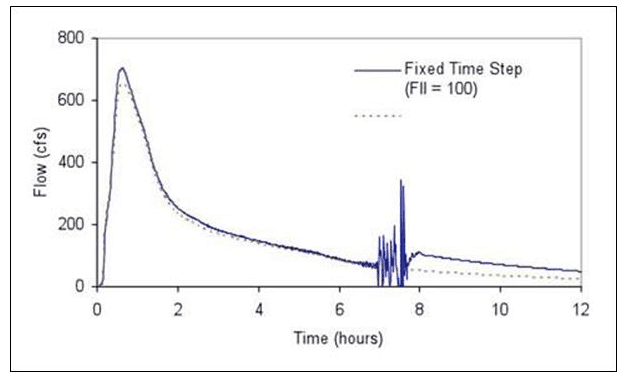Unstable Flow Routing Results
Due to the explicit nature of the numerical methods used for Dynamic Wave routing (and to a lesser extent, Kinematic Wave routing), the flows in some links or water depths at some nodes may fluctuate or oscillate significantly at certain periods of time as a result of numerical instabilities in the solution method. SWMM does not automatically identify when such conditions exist, so it is up to the user to verify the numerical stability of the model and to determine if the simulation results are valid for the modeling objectives. Time series plots at key locations in the network can help identify such situations as can a scatter plot between a link’s flow and the corresponding water depth at its upstream.
Numerical instabilities can occur over short durations and may not be apparent when time series are plotted over a long-time interval. When detecting such instabilities, it is recommended that a reporting time step of 1 minute or less be used, at least for an initial screening of results.
The run’s Status Report lists the links having the five highest values of a Flow Instability Index (FII). This index counts the number of times that the flow value in a link is higher (or lower) than the flow in both the previous and subsequent time periods. The index is normalized with respect to the expected number of such ‘turns’ that would occur for a purely random series of values and can range from 0 to 150.

Fig.131: Flow Time Series plot
As an example of how the Flow Instability Index can be used, consider the Figure shown above. The solid line plots the flow hydrograph for the link identified as having the highest FII value (100) in a dynamic wave flow routing run that used a fixed time step of 30 seconds. The dashed line shows the hydrograph that results when a variable time step was used instead, which is now completely stable.
Flow time series plots for the links having the highest FII’s should be inspected to ensure that flow routing results are acceptably stable.
Numerical instabilities under Dynamic Wave flow routing can be reduced by:
-
Reducing the routing time step
-
Utilizing the variable time step option with a smaller time step factor
-
Selecting to ignore the inertial terms of the momentum equation
-
Selecting the option to lengthen short conduits.
